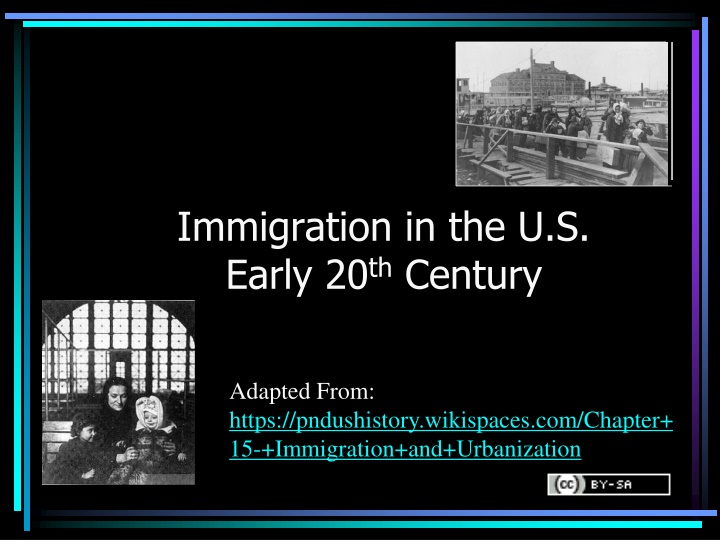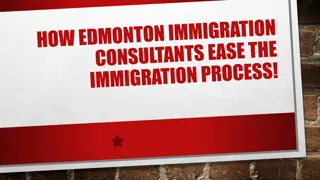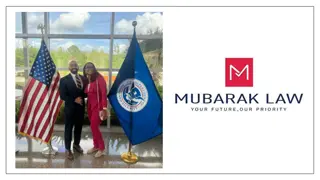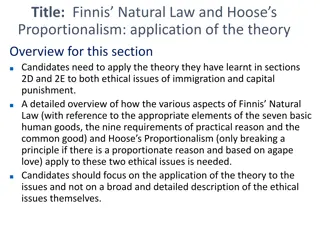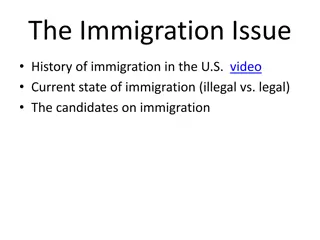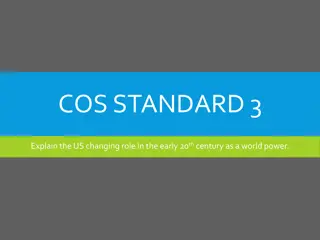Immigration in the U.S. in the Early 20th Century: Ellis Island Journey
Explore the journey of European immigrants to the United States between 1870-1920, focusing on their experiences at Ellis Island. Discover the challenges they faced from arrival to medical examinations and the lasting impact of over 12 million immigrants who passed through Ellis Island.
Uploaded on Sep 30, 2024 | 0 Views
Download Presentation

Please find below an Image/Link to download the presentation.
The content on the website is provided AS IS for your information and personal use only. It may not be sold, licensed, or shared on other websites without obtaining consent from the author.If you encounter any issues during the download, it is possible that the publisher has removed the file from their server.
You are allowed to download the files provided on this website for personal or commercial use, subject to the condition that they are used lawfully. All files are the property of their respective owners.
The content on the website is provided AS IS for your information and personal use only. It may not be sold, licensed, or shared on other websites without obtaining consent from the author.
E N D
Presentation Transcript
Immigration in the U.S. Early 20thCentury Adapted From: https://pndushistory.wikispaces.com/Chapter+ 15-+Immigration+and+Urbanization
Lesson Objectives 1. Describe the journey immigrants endured and their experiences at United States immigration stations. 2. Examine the causes and effects of the nativists anti-immigrant sentiments.
European Immigration 1870-1920 Mainly Eastern and Southern Europeans Motivated by religious freedom, political freedom, and economic opportunities Most arrive in the East through Ellis Island
Ellis Island An Immigrant s Journey
Stop 1: The Arrival New arrivals were taken by ferry to the main building at Ellis Island. The first immigrant to arrive was a 15-year-old girl from Ireland named Annie Moore to join her parents in New York City.
Did You Know? Over 12 million immigrants were admitted to the U.S. through Ellis Island
Stop 2: The Baggage Room The Baggage Room is where immigrants entered the main building. Immigrants with heavy luggage left it here until they were finished.
Did You Know? Over 40% of all Americans can trace their roots back to Ellis Island
Stop Three: Stairs to the Great Hall As the immigrants climbed the stairs to the Great Hall, doctors stood at the top and watched. They were looking for anyone having difficulty coming up the steps. examination. The "six second medical exam.
Stop Three: Stairs to the Great Hall If a medical problem or disability was suspected, 1 of 17 different chalk marks was put on the person's clothing. They were then sent for a full physical
Did You Know? Children were a common sight at Ellis Island. During its 62 years in operation, 355 babies were actually born on the island!
Stop Four: Medical Exam Medical exams were used to find people with contagious diseases If their problem was curable, immigrants were sent to the island's hospital. If it was not, the steamship company that brought them would have to pay to send them back
Stop Five: The Great Hall Immigrants waited here for their interviews with legal inspectors after finishing their medical exams. Process took 3-5 hours Some families stayed for days on Ellis Island, others for weeks, and still others for months.
Did You Know? The dining hall for detainees could seat up to 1,200. The menu featured beef stew or baked beans, and extra crackers and milk were provided at each meal for women and children.
Stop Six: Legal Inspection Immigrants had to prove they could legally come into America. They had to prove their country of origin and where they expected to live and work once they entered the country.
Stop Six: Legal Inspection Inspectors rejected any immigrant with a criminal record or those suspected of being indentured servants. By 1921, immigrants had to pass a literacy test and show a passport and visa
Stop Seven: Money Exchange Immigrants could exchange the money of their homeland for dollars, and purchase any train tickets they needed. Laws passed in 1909 required each immigrant to have at least 25 dollars before they were allowed to enter America.
Stop Eight: The Journeys End 2/3 of the new Americans then boarded a ferry to New Jersey, where the next leg of their American journey would begin. 1/3 took the ferryboat to Manhattan to begin their new life in New York City, only one mile away. Staff members referred to this spot as the kissing post because of all the emotional reunions that were witnessed there.
Asian Immigration 1851-1883 Chinese arrived to work on railroads Japanese arrive when US annexes Hawaii Arrive on West Coast through Angel Island
Life in the New Land Adjust to language and culture Many immigrants settle in isolated communities Immigrant organizations formed to help each other
Immigration Restrictions Nativism: Formation of Anti-Immigrant groups Quotas put into effect Prejudice Segregation in San Francisco Gentleman s Agreement of 1907-1908
Immigration Restrictions Chinese Exclusion Act - 1882 Backlash against Chinese laborers Act banned most immigrants from China
The Challenges of Urbanization Section 15-2 pp. 468-472
Preview Questions Why did people move to the cities? What problems did city dwellers face? How did reformers help the poor?
Urban Opportunities Urbanization: Rapid growth of cities Who was moving to the cities? Why did people move to the cities? Americanization Movement: Program to teach American culture to immigration
Urban Problems What problems were caused by urbanization? Tenement: Multifamily dwellings Often overcrowded and unsanitary Virtual Tour of a NYC Tenement
